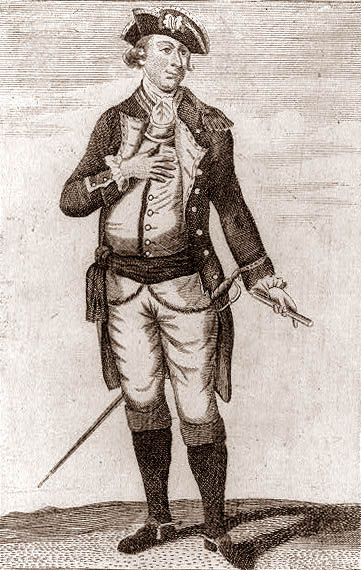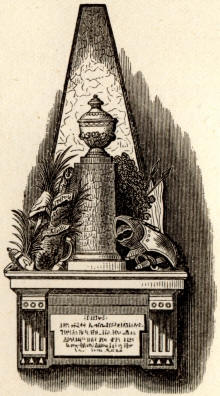|
This Site:
Discovery of America
The Explorers
Post Columbian Exploration
Thirteen Original Colonies
Colonization of America
Colonial Life
Colonial Days and Ways
Independence Movement
The Patriots
Prelude to War
Revolutionary War
Revolutionary War Battles
Overview of Revolutionary War
Revolutionary War
Timeline
Civil War
American Flag
Mexican War
Republic of Texas
Indians
|
 Montgomery,
RICHARD, military officer; born in Swords County, Dublin,
Ireland, December 2, 1736; was educated at Trinity College, Dublin,
and entered the army at the age of eighteen. Fighting under Wolfe at
the siege of Louisburg (1756), he won the approval of that
commander. After its surrender his regiment formed a part of
Amherst's force, sent to reduce the French forts on
Lake Champlain,
in 1759. Montgomery became adjutant of his regiment in 1760, and was
under Colonel Haviland in his march upon Montreal when that city was
surrendered. In 1762, Montgomery was promoted to captain, and served
in the campaign against Havana in the same year. After that he
resided in this country awhile, but revisited England. In 1772 he
sold his commission and came to America, and the following year he
bought an estate at Rhinebeck, on the Hudson, and married a daughter
of R. R. Livingston. He was chosen representative in the Colonial
Assembly, and was a member of the Provincial Convention in 1775. In
June following he was appointed by the
Continental Congress
one of the eight brigadier - generals for the
Continental army.
Appointed second in command, under
Schuyler, in the Northern Department, he became acting
commander-in-chief because of his superior's protracted illness. He
entered Canada early in September, with a considerable army,
captured St. John, on the Sorel or Richelieu River, November 3, took
Montreal on the 13th, and pushed on towards
Quebec, and stood before
its walls with some troops under
Benedict Arnold,
December 4. On the 9th the Continental Congress made him a
major-general. He invested Quebec and continued the siege until
December 31, when he attempted to take the city by storm. In that
effort he was slain by Montgomery,
RICHARD, military officer; born in Swords County, Dublin,
Ireland, December 2, 1736; was educated at Trinity College, Dublin,
and entered the army at the age of eighteen. Fighting under Wolfe at
the siege of Louisburg (1756), he won the approval of that
commander. After its surrender his regiment formed a part of
Amherst's force, sent to reduce the French forts on
Lake Champlain,
in 1759. Montgomery became adjutant of his regiment in 1760, and was
under Colonel Haviland in his march upon Montreal when that city was
surrendered. In 1762, Montgomery was promoted to captain, and served
in the campaign against Havana in the same year. After that he
resided in this country awhile, but revisited England. In 1772 he
sold his commission and came to America, and the following year he
bought an estate at Rhinebeck, on the Hudson, and married a daughter
of R. R. Livingston. He was chosen representative in the Colonial
Assembly, and was a member of the Provincial Convention in 1775. In
June following he was appointed by the
Continental Congress
one of the eight brigadier - generals for the
Continental army.
Appointed second in command, under
Schuyler, in the Northern Department, he became acting
commander-in-chief because of his superior's protracted illness. He
entered Canada early in September, with a considerable army,
captured St. John, on the Sorel or Richelieu River, November 3, took
Montreal on the 13th, and pushed on towards
Quebec, and stood before
its walls with some troops under
Benedict Arnold,
December 4. On the 9th the Continental Congress made him a
major-general. He invested Quebec and continued the siege until
December 31, when he attempted to take the city by storm. In that
effort he was slain by
 grape-shot
from a masked battery, December 31, 1775. His death was regarded as
a great public calamity, and on the floor of the British Parliament
he was eulogized by Burke, Chatham, and Barre. Even Lord North spoke
of him as "brave, humane, and generous;" but added, "still he was
only a brave, humane, and generous rebel; curse on his virtues,
they've undone his country." To this remark Fox retorted: " The term
'rebel' is no certain mark of disgrace. All the great assertors of
liberty, the saviors of their country, the benefactors of mankind in
all ages, have been called 'rebels.' We owe the constitution which
enables us to sit in this House to a rebellion." Montgomery was
buried at Quebec. In 1818 his remains were removed to the city of
New York, at the expense of
the State, and they were deposited near the monument which the
United States government had erected to his memory in the front of
St. Paul's Church, New York. grape-shot
from a masked battery, December 31, 1775. His death was regarded as
a great public calamity, and on the floor of the British Parliament
he was eulogized by Burke, Chatham, and Barre. Even Lord North spoke
of him as "brave, humane, and generous;" but added, "still he was
only a brave, humane, and generous rebel; curse on his virtues,
they've undone his country." To this remark Fox retorted: " The term
'rebel' is no certain mark of disgrace. All the great assertors of
liberty, the saviors of their country, the benefactors of mankind in
all ages, have been called 'rebels.' We owe the constitution which
enables us to sit in this House to a rebellion." Montgomery was
buried at Quebec. In 1818 his remains were removed to the city of
New York, at the expense of
the State, and they were deposited near the monument which the
United States government had erected to his memory in the front of
St. Paul's Church, New York. |
 Montgomery,
RICHARD, military officer; born in Swords County, Dublin,
Ireland, December 2, 1736; was educated at Trinity College, Dublin,
and entered the army at the age of eighteen. Fighting under Wolfe at
the siege of Louisburg (1756), he won the approval of that
commander. After its surrender his regiment formed a part of
Amherst's force, sent to reduce the French forts on
Montgomery,
RICHARD, military officer; born in Swords County, Dublin,
Ireland, December 2, 1736; was educated at Trinity College, Dublin,
and entered the army at the age of eighteen. Fighting under Wolfe at
the siege of Louisburg (1756), he won the approval of that
commander. After its surrender his regiment formed a part of
Amherst's force, sent to reduce the French forts on
 grape-shot
from a masked battery, December 31, 1775. His death was regarded as
a great public calamity, and on the floor of the British Parliament
he was eulogized by Burke, Chatham, and Barre. Even Lord North spoke
of him as "brave, humane, and generous;" but added, "still he was
only a brave, humane, and generous rebel; curse on his virtues,
they've undone his country." To this remark Fox retorted: " The term
'rebel' is no certain mark of disgrace. All the great assertors of
liberty, the saviors of their country, the benefactors of mankind in
all ages, have been called 'rebels.' We owe the constitution which
enables us to sit in this House to a rebellion." Montgomery was
buried at Quebec. In 1818 his remains were removed to the city of
grape-shot
from a masked battery, December 31, 1775. His death was regarded as
a great public calamity, and on the floor of the British Parliament
he was eulogized by Burke, Chatham, and Barre. Even Lord North spoke
of him as "brave, humane, and generous;" but added, "still he was
only a brave, humane, and generous rebel; curse on his virtues,
they've undone his country." To this remark Fox retorted: " The term
'rebel' is no certain mark of disgrace. All the great assertors of
liberty, the saviors of their country, the benefactors of mankind in
all ages, have been called 'rebels.' We owe the constitution which
enables us to sit in this House to a rebellion." Montgomery was
buried at Quebec. In 1818 his remains were removed to the city of